SDRSharp Users Guide
This is an excerpt from our book on RTL-SDR which we've decided to post given that many new users struggle to understand all the settings in SDR#.
SDR# is currently the most popular SDR program used with the RTL-SDR. It's easy to set up and use. To install SDR#, go through our Quickstart Guide. Below we explain some of the settings and displays in SDR#.
Upon opening SDR# you'll be greeted with the screen shown below. Here we have highlighted the main parts of SDR#
After opening SDR# for the first time, we suggest that you immediately remember to perform the following steps (if you don’t know what some of these steps are, continue reading further below for more information):
- Increase the RF gain from zero to a higher value in the configure menu.
- Reduce the range slider on the right of the SDR# window to about -70 (for RTL-SDR dongles).
- Enable the “Correct IQ” setting to remove the center spike if using an R820T/R820T2, or enable “Offset Tuning” in the configure menu if using an E4000/FC0012/13.
- Turn off the “Snap to grid” setting, or adjust the PPM offset accordingly.
- Set the 'Mode' to the correct setting for the signal that you are listing to.
Main Settings and Windows
Note that there is a distinction in SDR# between settings that affect the software side, and settings that affect the hardware side. All hardware side settings can be found in the Configure Menu window which can be accessed with the cog icon ![]() . In here are settings to control things like the RF gain and sample rate / bandwidth of the RTL-SDR. To optimize reception, you need to adjust settings in this window.
. In here are settings to control things like the RF gain and sample rate / bandwidth of the RTL-SDR. To optimize reception, you need to adjust settings in this window.
Most of the settings found in the main windows of SDR# affect the software digital signal processing (DSP) side of things. To optimize processing of the signal you need to adjust these DSP settings.
| Control/View | Explanation |
| Play Button / Stop Button |
This button is used to start and stop the SDR. |
| Source | This is a drop down menu which is used to select the SDR input device being used. If you are using an RTL-SDR, select RTL-SDR/USB. Be sure to NOT select RTL-SDR/TCP unless you are using a remote server with rtl_tcp. |
| Configure Menu |
Clicking this button opens up the configure menu. In here you can change settings like the sample rate (bandwidth) and RF gain. See further down for more information about these settings. |
| Frequency Input |
Use the mouse to set the desired frequency you wish to listen to here. You can either click on the tops and bottoms of each individual number to increase or decrease the value, or simply hover over the number you want to change and use the mouse wheel to alter the value.
The frequency input is divided into 4 sections with each section containing 3 values (e.g. 000.000.000.000). The first section represents GHz frequency values, the second MHz, the third kHz and the last Hz. For example to tune to a radio station at 88.6 MHz we would enter 000.088.600.000 into the frequency input. To tune to 861.5475 MHz we would enter 000.861.547.500. To tune to 1.575 GHz we would enter 001.575.000.000. To tune to 500 kHz (with an upconverter and appropriate offset shift set (discussed later)) we would tune to 000.000.500.000. |
| Volume | Set the volume level of your output speakers or audio piping device here. |
| RF Spectrum / FFT Display | This part of the window shows the RF spectrum as a graph in real time visually. Active signals will appear as peaks on this graph. |
| RF Waterfall | This part of the window shows the RF spectrum graph spread over time with new data at the top and old data at the bottom, just like a waterfall. |
| Tuning Bar |
The vertical red line in the RF spectrum graph shows where on the RF spectrum the RTL-SDR is currently tuned to. Within the currently active chunk of instantaneous bandwidth the tuning can be altered by simply using the mouse to click and drag the red line, or just by clicking elsewhere in the RF spectrum. The shaded rectangular area around the red line shows the bandwidth of the tuned area (don’t confuse this with the bandwidth/sample rate that is set in the configure menu). The bandwidth should be set so that it covers the area of the signal that is tuned. The bandwidth can be adjusted by using the mouse to simply drag the edges of the shaded area in or out. |
Radio Tab
Here you can choose what type of demodulation mode the signal at your currently tuned frequency should use.
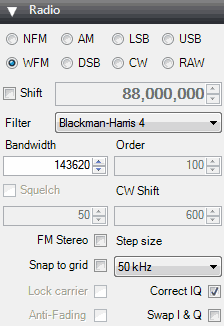
| Mode | Acronym Expansion | Explanation |
| NFM | Narrowband Frequency Modulation |
Commonly used mode used by walkie talkie radios, weather radio and most VHF/UHF digital signals. |
| WFM |
Wideband Frequency Modulation |
This is the mode that broadcast FM stations use (e.g. radio music stations). |
| AM |
Amplitude Modulation |
Used by broadcast AM stations that are receivable by normal shortwave radios and also used by air band voice frequencies used by aircraft and air traffic control. Some digital signals also use AM. |
|
LSB/USB |
Lower Side Band / Upper Sideband |
Used in the HF band by ham radio users to transmit voice and data efficiently with small bandwidths. |
| CW | Continuous Wave | Used for listening to Morse code. |
| DSB |
Double Side Band |
Similar use to AM, but requires centered tuning. |
| RAW |
Raw IQ signal |
Used for listening or recording RAW IQ data |
| Setting |
Suggested Default |
Explanation |
| Shift |
0 (No upconverter used) |
This box offsets the tuned frequency by the amount entered. This is useful if you are using an upconverter. For example if you have an upconverter with a 100 MHz oscillator, you would set the shift to be -100,000,000 (don’t forget the minus sign). Without the shift, when using an upconverter to tune to a signal at 9 MHz you would need to actually tune to 100 + 9 = 109 MHz. With the shift set, you can tune to 9 MHz as normal. If you have an upconverter with a 125 MHz oscillator you would tune to 125 + 9 = 134 MHz, or set the shift to -125,000,000. |
| Bandwidth |
NFM/AM: 12500, WFM: 250000 |
This is the width of the shaded part of the tunable area. You can set it manually here, or by dragging the edges with the mouse as described under the tuning bar description. |
| Filter |
Blackman-Harris 4 |
Changes the filter type used. Different filters have different shapes. The filter is used to select the highlighted signal in the RF window. Blackman-Harris is usually the best filter to choose and this setting almost never needs to be changed. |
| Order | 500 |
Changes the filter order. You may notice when using low filter orders that signals outside of the tuned bandwidth can still be heard. Larger filter orders “tighten” or “sharpen” the band pass filter used within the tuned bandwidth/IF thus preventing signals outside of the tuned bandwidth from being heard. You will want to increase the filter order when there are strong signals near to your tuned area. Using higher filter orders can cause a greater load on the CPU, so slow PCs may need to reduce this value. |
| Squelch | OFF |
Squelch is used to mute the audio when the signal strength is below the specified value. A larger value requires a stronger signal to unmute the audio. It is useful for when listening to speech as the sound of static when no one is talking will be muted. |
|
CW Shift |
600 |
Mainly useful for when receiving CW (Morse code) as it specifies the offset between CW transmit and receive frequencies. |
|
FM Stereo |
OFF |
Will enable stereo output for broadcast radio WFM signals, but can make weak stations sound worse. |
|
Snap to Grid / Step size |
OFF or set to band spacing |
In many bands frequencies are allocated at a fixed distance apart. For instance in most countries air band signals are spaced 25 kHz apart (or 8.33 kHz in some countries). Turning on snap to grid can help with tuning by causing the tuning bar to snap directly to a signal. However, to use this with a non-TCXO RTL-SDR the PPM frequency offset correction must be set correctly, otherwise the frequencies may not line up. The snap to step size can be set in the “Step Size” pull down menu. |
|
Correct IQ |
ON |
Should usually be selected as ON. This setting removes the small but annoying center spike that is present with R820T/R820T2 RTL-SDR dongles. |
|
Lock Carrier |
OFF |
Only active in AM or DSB mode. Allows for synchronous AM which can significantly improve reception and also automatically centers the signal on the carrier. Turn this on for better AM reception, but may increase CPU usage. |
|
Anti-Fading |
OFF |
Can be used when “Lock Carrier” is activated. Takes advantage of the symmetry of AM signals which helps with weak signals when they may be fading in and out. Turn this on for better AM reception, but may increase CPU usage. |
|
Swap I & Q |
OFF |
If you are using SDR# as a panadapter, some hardware radios may have the I & Q signals swapped and need this option checked. |
|
Mark Peaks |
OFF |
Simply marks any peak in the RF spectrum with a circle. |
Audio Tab
This tab allows you to adjust settings related to the audio processing.
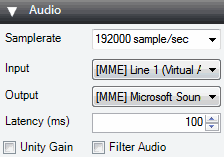
| Setting |
Suggested Default |
Explanation |
| Sample Rate | 48000 |
Sets the sample rate of your sound card. Some decoding software may require a specific sample rate to be set. Usually the default value should be fine for general listening. This is normally greyed out unless using a sound card based SDR. |
| Input |
A Sound Card |
Specifies the input sound card when using SDR# with the “Other (Sound Card)” source. Used mainly with sound card based software defined radios. In normal use with an RTL-SDR this does not need to be set. |
| Output |
Speakers |
Sets the audio output device. By default it is set to your speakers. If you are passing the audio to a decoder program here you would choose your virtual audio pipe (VAC/VB Cable) to send the audio to. |
|
Unity Gain |
OFF |
Should normally be unchecked as it sets the audio gain to 0 dB. |
|
Filter Audio |
ON |
Improves voice signals by filtering the audio, removing high pitched hiss and DC noise. Should normally be off if decoding digital signals, but may actually help in some cases if there is significant DC offset. |
AGC (Automatic Gain Control) Tab
Note that in some modes the AGC tab will be greyed out.
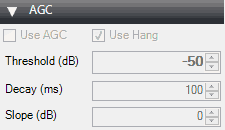
| Setting |
Suggested Default |
Explanation |
| Use AGC | ON |
Turns on the audio automatic gain control. The AGC will attempt control the audio volume level so that loud sounds are not too loud and quiet sounds are not too quiet. The default settings work well for voice audio signals. It is especially useful to turn this on when listening to AM/USB/LSB signals as strong signals in these modes may sound distorted otherwise. |
|
Use Hang / Threshold / Decay / Slope |
-50, 100, 0 |
Allows you to modify the default AGC behavior, though in most cases the defaults are fine. |
FFT Display
The FFT display settings adjust options related to the spectrum analyzer screen and the waterfall.
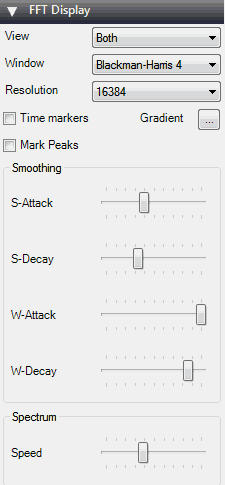
| Setting |
Suggested Default |
Explanation |
| View | Both |
Set it to view both the RF spectrum and the waterfall, or only one of them, or none at all. Removing the waterfall may be useful on older PCs with slow processing hardware. |
| Window |
Blackman-Harris 4 |
Sets the type of windowing algorithm to use on the FFT, the default of Blackman-Harris 4 is the best in most cases. |
| Resolution | 32768 |
Increasing the resolution will increase the quality of how the signal looks in the RF display and waterfall. Using a higher resolution may be useful when fine tuning, as high resolutions will allow you to see the peaks and structure of a signal much more clearly. Beware that high resolutions can slow your PC down and can cause trouble especially with single core machines. Generally, a value of at least 32768 should be used if your PC can handle it. |
|
Time Markers |
OFF |
Adds time markers on the waterfall display, so you know at what time a particular signal was broadcasting. |
| Gradient |
Allows you to customize the colors used in the waterfall display. |
|
|
Mark Peaks |
OFF |
Adds a circular marker on every signal peak on the RF spectrum. |
|
S-Attack / S-Decay |
Changes the amount of smoothing and averaging done in the RF spectrum display. |
|
|
W-Attack / W-Decay |
Changes the amount of smoothing and averaging done in the waterfall display. |
|
| Speed |
Changes how fast the RF spectrum and waterfall updates. |
Zoom FFT
Zoom FFT is a plugin that comes by default with SDR#. It creates a zoomed in RF spectrum display of the tuned IF bandwidth at the bottom of SDR#.

| Setting | Explanation |
| Enable IF |
Opens a “zoomed in” RF spectrum graph around the area of your tuned IF bandwidth. Allows you to see the signal structure with much greater resolution. |
|
Enable Filter |
If Enable IF is checked, then you can enable a special adjustable IF filter. This filter allows you to filter the left and right side of the tuned IF bandwidth individually. |
|
Enable MPX |
Enables you to see the MPX spectrum of a broadcast FM radio station. Broadcast FM is encoded in a special baseband audio format called MPX. It contains a mono section, a pilot tone and a stereo section, as well as sometimes subcarrier sections for data like RDS and special radio services like SCA. If you were to try and view the audio baseband with the “Enable Audio” button, you wouldn’t see the MPX structure because SDR# would have processed it into normal audio, and discarded the subcarriers and other sections. |
|
Enable Audio |
Allows you to see the audio (baseband) spectrum. |
SDR# Digital Noise Reduction
It is useful to turn on digital noise reduction when listening to weak and noisy analogue voice signals. This setting will attempt to reduce the background ‘hiss’ sound. There are two DNR options available, IF and Audio. The IF uses the noise reduction algorithm on the IF signal and the Audio option does it on the output audio signal. Usually the IF digital noise reduction works best and should be tried first, though a combination of both may work best. The sliders control the strength of the algorithm applied, and the profile can be optimized for the type of audio you are listening to. The profile options are Hi-Fi, Talk, Speech, Narrow Band and custom.
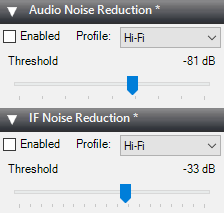
Noise Blanker
The noise blanker is an algorithm that can be turned on to help reduce impulsive and pulsing like noise from sources like spark gaps. Examples of this type of noise may come from motors, electricity lines, power over Ethernet and switching power supplies. Carefully using this option can really help when receiving a weak signal amongst pulsating noise, which is mostly common on the HF bands. The noise blanker works by simply removing any samples that have large pulses of energy in them.
In SDR# there are two different types of noise blanker. The baseband noise blanker works on the entire spectrum and will remove pulses from the FFT and waterfall, whereas the demodulator noise blanker only works within the tuned area that is currently being demodulated. Tuning the settings is mainly an exercise in trial an error. Move the sliders until the pulsating noise goes away, whilst trying to keep the signal active.
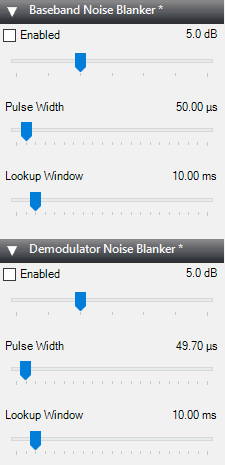
Recording Tab
The recording tab allows you to make I/Q and Audio recordings. The sample format allows you to choose the level of recording quality needed. Since the RTL-SDR is only about 8-bits, we can select the lowest 8 Bit PCM option. Using only 8-bits saves a significant amount of disk space.
An I/Q recording is a recording of the entire ~2 MHz bandwidth that you are currently tuned to. It saves the RF data within the bandwidth so you can replay it at a later time. An I/Q recording can be made by checking the “Baseband” check box. Note that I/Q recordings can use up a lot of disk space, so make sure to watch the File Size and Duration status counters. I/Q recordings can be played back in SDR# by selecting IQ File (*.wav) from the source menu. If you receive a lot of dropped buffers, then your PC or disk may simply not be fast enough to process the recording. Remember that baseband recordings use a lot of disk space.
The audio coming out of the speakers can be recorded by checking the “Audio” check box. This will record audio to a standard audio .wav file. All recorded files are stored in the same folder as the SDR# executable.
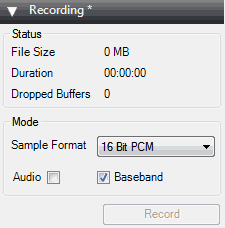
Frequency Manager Tab
The frequency manager allows you to save any frequencies of interest in a database. A new frequency can be added to the database by clicking in the New button. This will add a frequency with the current tuned frequency and settings like bandwidth. You can edit the frequencies name and put it into a group for easy management. Double clicking on a stored entry will instantly tune SDR# to that frequency, and set the stored mode and bandwidth.
If you check the “Show on spectrum” check box then your saved frequencies will be displayed in the RF spectrum.
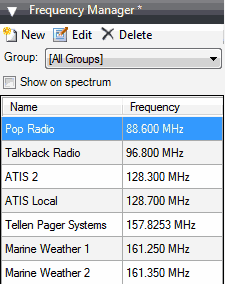
Right hand side sliders
The sliders on the right adjust the graph display settings for the RF spectrum and waterfall.
| Setting |
Suggested Default |
Explanation |
| Zoom |
Zoomed out |
Moving this slider will cause the RF spectrum and waterfall to zoom in on your tuned IF bandwidth area in order to see a signal closeup. However, the more you zoom in, the lower the resolution will seem. An alternative to zooming is to either reduce the sample rate, or to use the special decimation drivers. These alternative methods will preserve the visual resolution and allow you to see the signal structure much more clearly. |
| Contrast |
Adjusts the contrast of the waterfall. Adjust it so that signals clearly stand out from the background noise. |
|
| Range |
-70 |
Modifies the dB level range shown on the left (vertical) axis of the RF spectrum window. You should adjust this so that the noise floor sits near the bottom of the RF spectrum window. This will allow signals to be more visible in the FFT RF spectrum and waterfall displays. As the RTL-SDR has a dynamic range of approximately 50 dB (plus a little more after oversampling/decimation), you will not need a range much higher than 0 to -70 dB. This setting will also affect the contrast in the waterfall and may help make weak signals easier to spot. 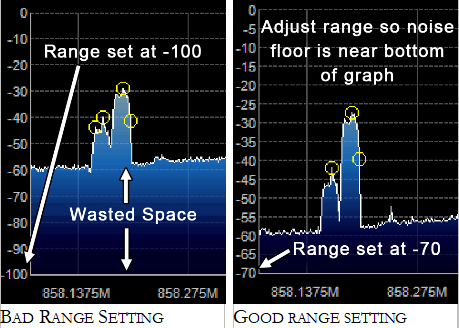 |
| Offset | 0 |
Adds an offset to the dB level range in the RF spectrum window. The offset is added to the top value on the dB level range in the RF spectrum. Usually there is no need to adjust this, but if you want to get really good contrast on weak signals, adjust this along with the range so that the signal height is the same height as the vertical axis. This setting will also affect the contrast in the waterfall and may help make weak signals easier to spot.
|
Configure Window / RTL-SDR Controller
The SDR# configure window can be accessed by clicking on the cog icon ![]() at the top of the SDR# window. The settings in this window affect the actual RF performance of the RTL-SDR, and should be set correctly to optimize the signal to noise ratio (SNR). The configure window has several options which are described below.
at the top of the SDR# window. The settings in this window affect the actual RF performance of the RTL-SDR, and should be set correctly to optimize the signal to noise ratio (SNR). The configure window has several options which are described below.
Remember that some options may be greyed out until you press stop in SDR#.
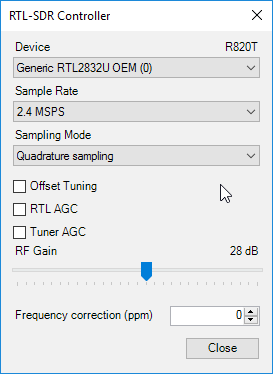
| Setting |
Suggested Default |
Explanation |
| Device |
Your RTL-SDR |
If you have multiple RTL-SDR dongles plugged in, the device drop down menu allows you to choose between them.
|
|
Sample Rate |
2.048 or 2.4 MSPS |
Lets you choose the size of the instantaneous bandwidth the RTL-SDR should display. Generally settings of up to 2.8 MSPS work well on most PCs, but if you have a slow PC you may want to reduce this. We recommend a default rate of 2.048 or 2.4 MSPS. |
|
Sampling Mode |
Quadrature Sampling |
Use Quadrature sampling for normal operation. The direct sampling selections should be used when using an RTL-SDR that supports it. |
|
Offset Tuning |
R820T/2 : OFF E4000/FC0012/13 : ON
|
Only useful for the E4000/FC0012/13 tuners. Selecting this will get rid of the large spike in the center of the spectrum that is present with the E4000/FC0012/13 zero IF tuners. |
|
RTL AGC |
OFF |
Enables automatic gain control on the RTL2832U chip. This is normally not useful as selecting this usually degrades reception. |
|
Tuner AGC |
OFF |
Enables the automatic gain control system on the tuner chip. Can be useful for general browsing, but it is almost always better to set the gain manually. |
|
RF Gain |
Adjust for best signal to noise ratio |
This slider can be used to set the tuner RF gain manually. Will not be active if Tuner AGC is checked. |
|
Frequency correction (ppm) |
TCXO Dongle: 0 Standard Dongle: Adjust for freq. accuracy. |
Allows you to correct the frequency offset that RTL-SDRs have from having low quality crystal oscillators.
|
Setting the RF Gain
There are three RF gain settings that can be found by clicking on the Configure button. RTL AGC turns on the RTL2832U chips internal automatic gain control (AGC) algorithm. Tuner AGC enables the RTL-SDR tuners AGC. The AGC’s attempt to automatically optimize the SNR of the signals. Finally, the gain slider can be used to manually set the gain.

The AGCs used in the RTL-SDR are designed to be used with wideband DVB-T signals, and do not work very well with narrowband signals. We recommend using manual gain control at all times to optimize the gain of a signal, however for casual browsing turning on Tuner AGC may suffice. RTL AGC is almost never used as it tends to just introduce a lot of unwanted noise.
The goal when setting the RF gain manually is to try and get the signal to noise ratio (SNR) as high as possible. This means that the maximum signal strength should be high, but the noise floor should also be as low as possible.
When increasing the gain, there will come a point at which the noise floor begins to rise faster than the signal strength rises. This is the point at which you should stop increasing the gain.
You can calculate the signal to noise ratio by subtracting the peak signal height from the height of the noise floor.
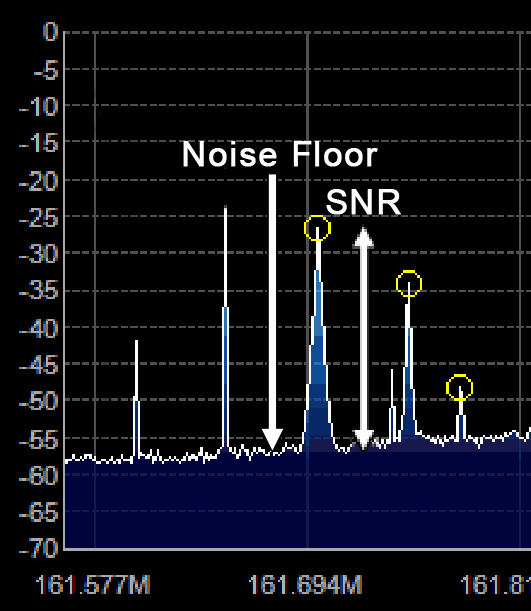
What Overload Looks Like
In SDR's (and all radio's for that matter), overload is when a signal that is too strong enters the radio and causes “saturation”. An analogy might be trying to listen to your friend talking to you at a loud concert. The music from the speakers is so loud that you can't hear what they are saying. The same thing can happen in radios. For example if the SDR cannot cope with a strong signal and starts overloading, weaker signals will no longer be able to be heard. This can happen even if there is a strong signal hundreds of MHz away from your target signal, though the closer in frequency it is the more problematic it will be. The biggest causes of overload are broadcast FM signals, pagers, TV broadcasts, DAB radio and GSM signals.
The first solution to overload is to simply turn the gain down. But turning the gain down can also make your desired signal weaker, so ideally you'd use a filter to remove those unwanted strong signals, or buy a more expensive 12-bit or higher SDR which can handle strong signals much better. In this section we'll show you what overload looks like on SDR#, so you'll know when to recognize if there is a problem.
Overload can manifest itself as images of the strong signal at frequencies where they're not meant to be. For example in the image below there are broadcast FM stations at 206 MHz, and they definitely should not be there. Simply turning down the gain causes them to disappear.
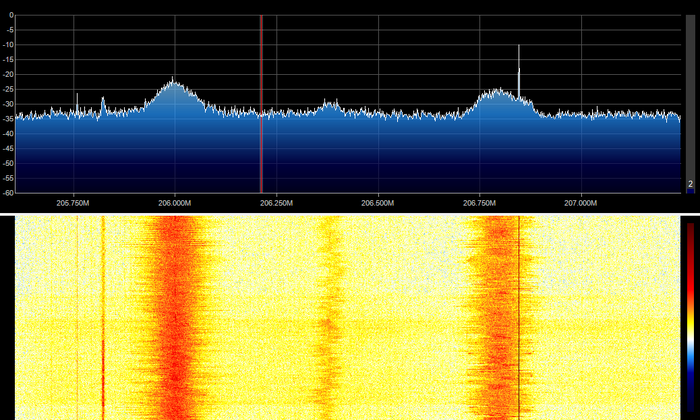
It can also manifest as a rise in the noise floor. For example in the image below a strong pager signal is causing the noise floor to rise whenever it transmits, and then fall again when it stops.
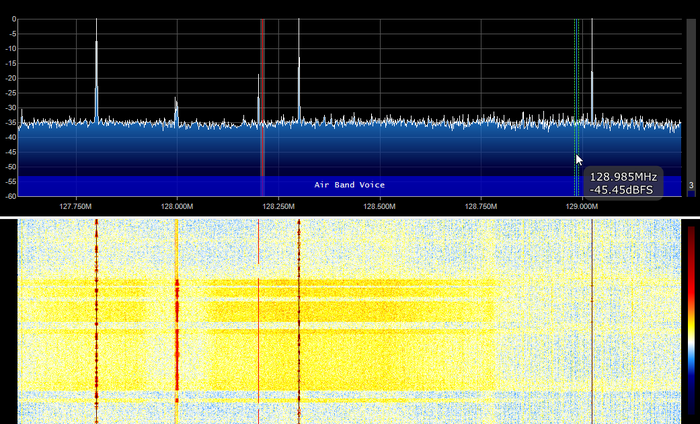
If you are tuned only a few MHz away from a very strong signal it can cause all sorts of weird images to show up . For example in this image below, whenever the pager transmits it causes strange signal spikes all over this part of the spectrum.
Of course overload can also cause the noise floor to rise so high that the signal is no longer visible at all.
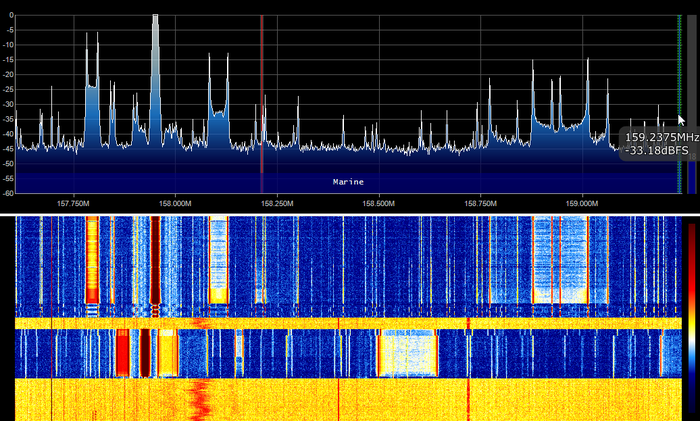
SDR Sharp Plugins
There are many plugins available for SDR# that extend its functionality. We recommend visiting rtl-sdr.com/sdrsharp-plugins for a list and brief overview of these plugins.
To install plugins you will most often need to copy a .dll file to the SDR# directory and add a 'magic line' text entry to the Plugins.xml text file which can be found in the SDR# directory. You will need to open this file in Notepad or another text editor to read it. The readme file that usually comes in the plugin zip file will usually tell you what the 'magic line' is. The line should be added between the <sharpPlugins> </sharpPlugins> tags.
Note that some older plugin readme files may still instruct you to add the line to the SDRSharp.exe.config file. This was used in older SDR# versions and is now incorrect. The line should be added to the plugins.xml file now.

 If you enjoyed this tutorial you may like our eBook available on Amazon. The Hobbyist's Guide to the RTL-SDR: Really Cheap Software Defined radio. |
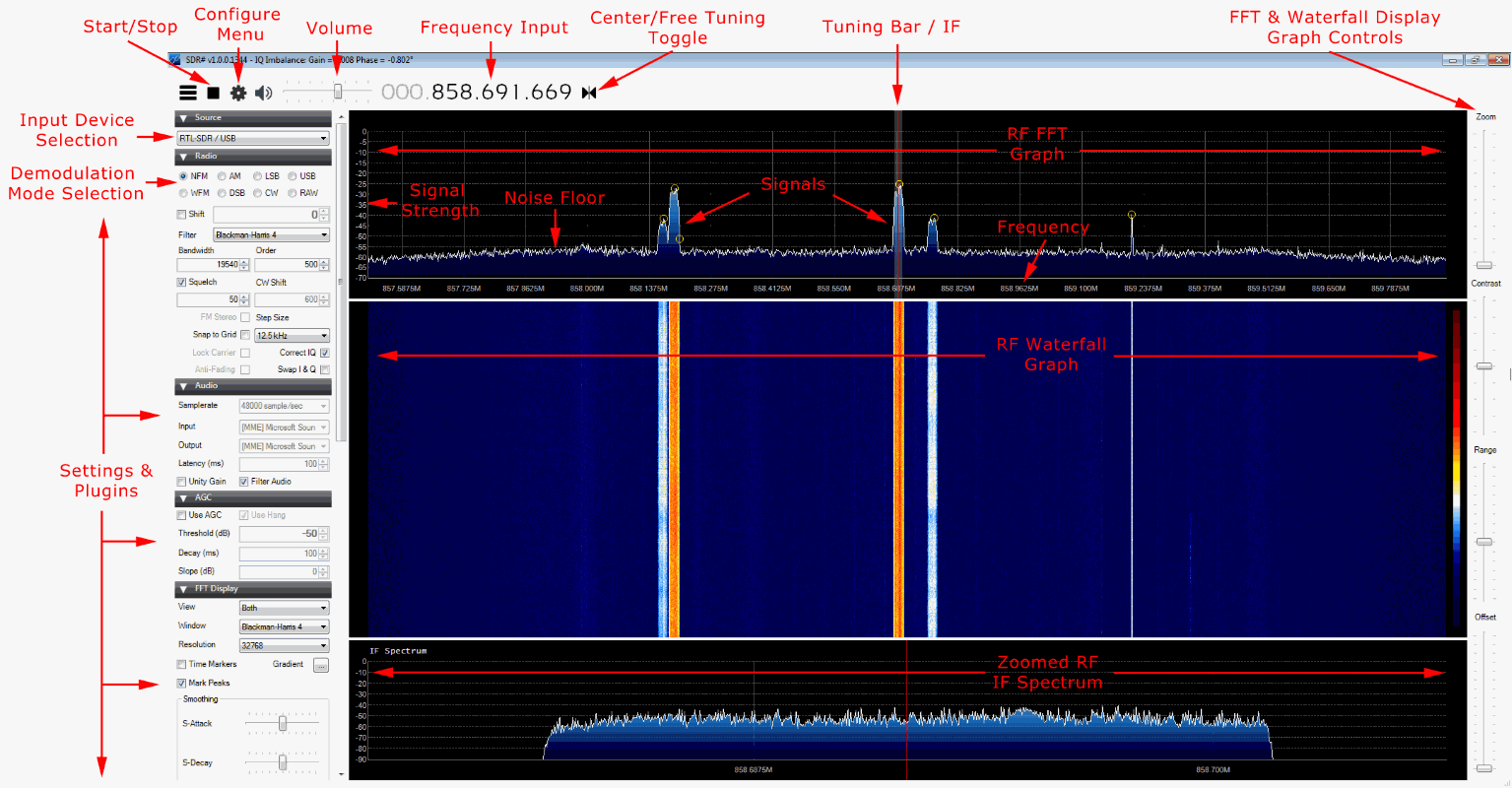
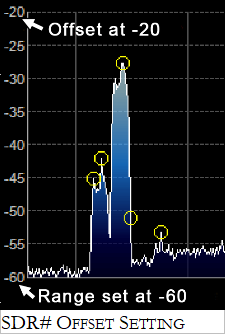
John Make sure you have downloaded and installed rtlsdr.DLL and, zadic-2.6.exe and copy and past into file sdrsharp-86 Then reboot computer should work.
All the best,
George, Alberta Canada
hello John, Make sure you have downloaded and installed rtlsdr.DLL and, zadic-2.6.exe and copy and past into file sdrsharp-86 Then reboot computer should work.
All the best,
George, Alberta Canada
When I press play in AIRSPY all I get is “No Device Selected” even tho SOURCE is set to RTL-SDR USB.
My computer reports this device is working correctly.
Win7 Home Premium Ver 6.1 SP1
John my remedy was finding an RTL-SDRinstal.bat file that didn’t unzip in the sdrsharp folder. I searched it with the Window button on the keyboard. It installs device drivers I believe. Solved my problem
Same prob. Did a cold restart of my windows 10 computer with unit plugged in and it took care of that prob. Computer would not recognize plugging unit into usb while running.
How do i disable all the the automatic setting that change while tuning around the spectrum.
i want SDR sharp stay setup in particulare way until I the user decides i want or need to change it and not constantly have to re adjust things like tuning step increment away from 1hz or the filter order away from 10 and band width 5khz or the demodulation mode, or the squelch mode being constanly turned on or off.
is there a a line that can be added to the config file to disable all radio automation so i can use sdr sharp the way i want it to operate.
Using (rtl-sdr) is it possible and ,if yes, how to demodulate modern digital modulation radio signals such as ASK, FSK, GFSK, GMSK, MSK, PSK, QPSK…etc, please? Thank you.
Best regards…
Is it possible and if yes how to demodulate modern digital modulation radio signals such as ASK, FSK, GFSK, GMSK, MSK, PSK, QPSK…etc using rtl-sdr?
fldigi can be used along with the sdr to decode them
como se puede eleminar o reducir la voz en OFF de las indicaciones?
Hi when i start SDR sharp press start, it put up a message [ no device selected ] but it shows it in the correct window help needed.
My SDR# does not update the frequency after I have tuned to a new “displayed” frequency. It only works once on intial startup then quits. Tried two different dongles, same symptoms. Have re-installed drivers with no change. Wndows 10 on a lap top. USB 2.0. Any suggestions ? Gene
just installed the latest version of AIrspy/SDRsharp with all the add-ons, Tetra, Signal meter etc.
why is it so slow, crashes, and lagging ??
SDR# v1.0.0.1732
really buggers my laptop up,
the old version was fine i used, now it’s killed my laptop going to have to uninstall and go back the HDSDR.
The latest versions of Sharp are skinned and really slow to load plus it’s created issues with some of the 3rd party plugins. As is normal for the developer it’s a case of tough, get on with it because I know best attitude and refuses to release an plain version of the current build, his baby, his perogative I guess. If you want to stick with Sharp the final unskinned version is still on the website.
On a slightly different subject I’ve recently discovered the SDRPlay SDRs can be used with the latest Sharps by replacing the extio with the version linked too here; https://www.rtl-sdr.com/forum/viewtopic.php?t=5156
Hi,
I would like to use SDR# with an antenna requiring power supply, so I wonder if there is a way in SDR# to enable BIAS-T.
Thanks,
73!
Nick – LZ1ZM
Until recently I have been using SDR# with a dongle and windows 8.1 to receive airband voice without any problems however after having to uninstall the programme and reinstall I can receive VHF radio programmes but no longer the airband frequencies. Has anyone any suggestions? Nothing else has been altered I am still using the same antenna etc.
My RTL-SDR with Sharp works fine with FM audio but when I go to AM HF with Sampling mode, I get good RF signals but the audio is not legible. All I get is noise on the signal.
What are your demod settings like? Best to post a question like this in the forums, with screenshots.
I am using an AirSpy HF+. Under the cog wheel I can not find the rf gain control. It is not displayed anywhere. So where is it hidden?
I have purchased an AirSpy HF+ Discovery and installed SDR# to support it. I too have not been able to find many of the documented features above such as RF Gain. Not only that but I am disappointed in the lack of overload protection, and the very limited spectrum display, a maximum of 1.3 MHz and my sample rate is only 782 kps with nothing higher even offered as an option. I am operating a dedicated Windows 7 machine with 4 Gb RAM. Surely this is enough processing power. The receiver is useless for noise floor studies, and I have been utterly unable to implement any kind of asymmetric AM sideband cutoffs, which make the receiver functionality on a par with a vacuum tube superhet receiver in that I am unable to cut out interference close in to an AM carrier on one sideband but have full audio recovery from the opposite sideband. These features drew me to SDR and I am extremely disappointed that the AirSpy and SDR# provide nothing more than an average casual shortwave radio listener experience with some eye candy. Anyone looking for SD receivers for RFI location, antenna system evaluation (where a look at 10 to 20 MHz of spectrum is important) should find another product.
I have found IF Processor & Tracking Notch Filter Plugin and installed it. It may provide the asymmetric AM sideband filtering I was looking for.
You need to read the specifications before you buy. The bandwidth is clearly stated in the specs, it’s a tradeoff of overload protection versus bandwidth, hard to have narrow filters with wide bandwidth.
Is it possible to record in mono and to choose the sampling rate? How? Thanks
I am trying to get my SDR V3 to tune 500 kHz – 30 MHz. I have the sampling mode set to direct sampling (Q branch). I cannot get the program to start. I press start and very quickly it reverts back to stop. What am I doing wrong?
When it starts working then you don’t do anything wrong. Is your computer OK?
Attention! When you want to receive up to 30 MHz with direct sampling you need a very very good preselector: all signals are imaged around 14.4 MHz. In fact you can receive 500 kHz to 13 MHz and 16 to 28 MHz with a poor image rejection around 14.4 MHz. Around 14.4 MHz you will see image spurs: level depending on your preselector selectivity.
I’m playing with a new Airspy HF+ Discovery and SDR#. Question: Is there a notch filter option somewhere in this system? That is, if two AM shortwave stations are close to one another, such that their carriers are causing a whistle, is there a way to remove either the carrier of the unwanted station in the IF passband, or the audio whistle frequency in the audio passband? This is a common feature on high-end shortwave radios. Thanks.
–Art
No notch, but this helps: first activate in ZOOM FFT both ENABLE IF and ENABLE FILTER. Then you can remove one sideband, of course the sideband that contains the unwanted signal carrier of modulation content. Thanks to the high-order filter you can go close to the wanted carrier with the filter edge. I use this a lot; specially in DSB reception of AM signals (also activate LOCK CARRIER and tune within 100 Hz).
every time my freezer kicks in i loose reception on sdrsharp /hdsdr..and i have to turn my pc of and start over again if i don’t turn pc of sdrshsrp /hdsdr wont work .but i can still get the internet ok .just the radio wont work ..
i have used different plugs in home but still the same thing..
Probably the result of two errors. The freezer needs a RC snubber to prevent the RF interference from switching reaching your in-house power lines. The second error is that the USB port of your computer is the (grounded) counterpoise of the unwanted voltage peaks (with RF content) on your in-house power system. May be you can connect the USB-ground at the USB connector directly to the ground of your computer power connection. Then there is no, or a lower voltage, between the “grounds”. In case of low-frequency reception (up to 13 MHz) the use of an isolating RF transformer (100 uH:100 uH and low capacitance between primary and secondary) will solve the problem too.
thank you for all that …sorry for late replie .i will get some one to read this and see what can be done …
thought i would say what as i have done.. updated bios ..put more ram in and better cpu ..now after a week the sdr v3 as not gone of when freezer kicks in ..i can see it in radio as a line across the screen ..as to be that ..fingers crossed its gone away …thanks jeff…dell 755 sff..
Can anyone suggest a commercially available “isolating RF transformer”? All I can find online are normal plug-in isolation transformers for house current, and I assume the one mentioned above has extra features designed into it.
John, just saw your question and see that it is e sequel to my earlier post for Jeff. The isolating transformer that I have in mind is in the antenna signal coax. Start from the beginning: interference from the main (computer supply) needs to be attenuated with a commercial available filter. Or obtain it from an old computer supply. That isolates or attenuates the mains interference from the computer. Then, more important, the ground from the computer, and thus your SDR ground, must be isolated from the antenna ground. There are two options. #1 isolating transformer with primary and secondary. For shortwave this can be a 100uH to 100 uH ferrite transformer (see bamlog.com diyxfmr.htm) on ferrite 302 material. This transformer does not allow phantom supply of an active antenna. #2 common-mode isolator transformer. Depending on the frequency range the inductance has to be in the 100 uH range up to 10 mH. Sounds as impossible but can be done with 60 windings twisted wire (copper-enamel 0,2 mm) on a core that gives 3 uH per turn. That transformer inserts 2 Ohm DC in your phantom supply and, check it, maximum 1,5 dB attenuatio at 30 MHz. The ground-coupled interference isolation is more than 20 dB from 100 kHz to 15 MHz. Just to be sure, this is my signal path: active antenna in my garden with ground (pin 2 meters deep, about 80 Ohm RF at 1 MHz); then connection with coax via common mode transformer (#2); 20 meters coax up to my house: coax screen is grounded here before it goes up to my shack; then a second common-mode transformer before it is connected to my SDR. Result: very clean reception from 10 kHz up to 30 MHz with noise equivalent field strength of 4 uV/m in 3 kHz bandwidth. May be I can post a realisation example picture here below. Succes, Brightnoise (PA0FSB)
… 4 uV/m in RBW 3 kHz at 1500 kHz…
Can’t post a picture here. Or do I oversee this option?
the frequency manager doesn’t appear to allow me to delete groups.
I just downloaded it Aug 19. I didn’t really understand the groups and by the time I realised there could be instances of the groups I had already made to many groups.
How do I delete unwanted groups?
from the looks of the current code, there is no way to edit the groups.
However, if you’re familiar with XML files, there is a file named Frequencies.XML.
this can be edited.
I found that if you exit the app and restart, any groups w/o frequencies are deleted.
I was thinking of writing a small application to edit this XML file
You cant delete whole groups but You can edit the file
frequencies.xml (can edit it in notepad an leave just this inside
now when You open back up SDR sharp You wont have any frequencys at all in there
the program only allows us to delete 1 at a time…also default hapens to add them twice ‘so to speak’ once as misc an again as favorite group ‘so You end up havin all them twice in the list which can lead to bloating but I disabled the check mark to add to favorites n just ‘add them now to misc ….HAVENT GOT THIS FIGURED OUT YET …still gettin just radio stations ghost over n over in diff ranges but its same crap repeated and nothin but radio EVEN ENABLE TEE N CHANGE MODES AND HEAR NOTHING AT ALL
Ug… the volume slider suddenly greyed out for WFM and only WFM. Was working good for a while then suddenly sound cut out and I’m at my wits end trying to get it to work.
I am getting the device not found error when I click the play button on SDR#. I’ve uninstalled and reinstalled following all the directions and everything says successful. I have also tested the rtl-sdr on another device and it works with that. Im lost.
I am unable to get SDRSharp to recognized my LTDZ-35-4400M board. It does work with WinNWT5.
Would you have any tips on getting it working with SDRSharp?
Thanks
Is there a way of observing a much wider frequency range in the spectrum window? I need to search for offending transmitters that may be putting out huge sidebands that are interferring with normal WFM signals. The main spectrum window is always less than 2MHz wide. I’m looking for something like 50 to 100MHz wide.
I am using RTL-SDR as a Panadapter. If I set up the scanned frequency range center at, say, 14.200 MHz and then click on an indicated signal at 14.108, the scale moves and 14.108 is then in the center of the screen. This is highly annoying. How can I lock down the frequency scale? Just can’t seem to find that option.
[email protected]
\
Thanks.
To the right of the frequency selector at the top there is a setting that gives three options that will solve your problem…they allow Centre Tuning, Free Tuning or Sticky Tuning. You seem to be on Centre Tuning.
I need help! On the config Menu (cog icon) for the RTL-SDR (USB), the options for choosing my device are grey out, I can´t select anything, I already change the drivers with zadig, and reinstalled SDR#. I´m using the Nooelec NESDR smart dongle.
Hi Chaq. If you have only one sdr dongle it Will be grayed out. If you had two or more you would select them from here. In the greyed out area it should say something like :-
Generic RTL2832U OEM (0).
If you follow the line along where it says ‘Device’ it should say something like :-
R820T.
The above is taken from my NooElec R820T2 NESDR Mini 2+.
If there is nothing in the (greyed out) Device box then you will have to run zadig again to replace/reinstall the relevant drivers.
Mark.
Chaq, Also do not forget to select ‘RTL-SDR (USB)’ as source on the left side of the SDR# window.
Mark.
By far the best setup guide I have found. The user guide was very helpful. SDR is relatively new to me so still learning what is all about. Most of my experience is with amateur radio.
I have problem with recording audio when using SDRSharp and RLTL-SDR.
I want fixed gain, not automatic gain control for audio.
The problem is that all signal but the weakest will causes the recorded audio to be
saturated with disastrous result.
How do I adjust the recording level manually ??
Here is what audacity show:
 ?dl=0
?dl=0
Any suggestion ?
Hello everybody,
I run an RTL SDR server from Osmocom on my Raspi. This is now also in operation for 2-3 months. I am very satisfied with the idea of the SDR server, the result is very good on VHF and UHF.
A few days ago I bought a new RTL SDR receiver, this time also for the KW reception. The KW reception is possible via direct sampling. With the new stick, however, I have the problem that the sampling mode selection of the SDR # v.1.0.0.1700 only with RTL-SDR (USB) is available as a source USB. If I select RTL-SDR (TCP) as source, I do not get sampling mode selection to toggle between quadrature sampling and direct sampling (Q branch). Unfortunately, it is still possible to receive only VHF and UHF via the SDR server.
On the iPhone I have an app installed, with this is the switch to Direct Sampling possible. So it’s a problem of SDR # and not of the server
About USB the making a selection for the sampling mode in the SDR # as I said possible, under TCP, this selection point just does not exist.
I would be really grateful for help
Greetings
Michael
How do I save signal data as a file using SDRSharp?
how to receive digital modulated and amplitude modulated(AM) audio signals on this software?
I’m not the sharpest tool in the shed when it comes to computer language. I see all the comments about…s/ware control, Zadig driver, copy in “BandPlan.xml” and “frequencies.xml”…and so on, and it’s all hieroglyphics.
I purchased an RTL-SDR a year ago, and tried to get it to work on a laptop, but couldn’t so i sold it to a friend; dont know that he got it to work either.
I want to play too like you guys 😉 , and have been doing RF for over 30 years; building/maintaining POCSAG/GOLAY paging towers, VHF/UHF repeaters, and 800MHz Motorola/GEDACS/LTR trunking systems, but am LOST with the computer lingo.
What is the easiest way to get one of these up and running on my laptop?
1. Is there a booklet/website that can decipher all the programming coding that i can learn from?2
2. Can I purchase a setup that’s plug-n-play?
Thanks,
Jimmyg
Hi Jimmy,
SdrSharp is daunting as it is so powerful with a large number of user settings.
We use SdrSharp to set up recording systems, and have a .zip file that have everything pre-set to suit our specific situation. This might work for you too, and once you something (anything) working you can modify it from there.
Let me know…
Cheers,
Harvey
[email protected]
I’ll send you the .zip files that we use when setting up a new recording system using SdrSharp. These might (or might not) work in your situation, but if they work at all will give you a starting point.
Cheers,
Harvey Lockie
Hello, is there a method to play a .wav file on my computer that is not recorded using the SDR#? I am recording reception using a kiwisdr radio accessed over the web. I would like to use SDR# audio capabilities to clean up the reception. I get “invalid file format.” Is there a way around this?
Thanks, JOhn
I’m not familiar with the kiwisdr, but is there an option to save as some form of raw IQ file ? If there is not then you are trying to manipulate an audio file with software that is designed to process and manipulate raw IQ data. You might have better luck using audacity or even Adobe Audition which are designed to process audio files (and know nothing about raw IQ data).
How to hook up a coax cable that is on one end connected to a splitter that is connected to the internet providers hub with tv, internet connectors.
That all works connecting the other end simply to a coax connector on a tuner, female.
Now, I got this little screw without pin on the dongle.
I got a sma to sma connector. I can screw this on.
Then on this connector another connector, female to another end to hook the coax on.
But I do not know if these are right connectors to use.
Can anybody explain which connectors to use. I also saw a t-uhf connector, female to sma…
What a bunch of connectors my God.
Just to hook up a coax cable. The test antenna only picks up strong stations.
Thanks.
Ignace
Belgium
Is there any way of invoking SDR# in ‘play’ mode?
I’m running it on a remote machine so am not on site to click the ‘play’ triangle. I’m clicking it under s/ware control, but that’s not ideal as the computer is sometimes busy with updates etc.
regards
I want to install orbitron in the latest version of sdrsharp maybe someone could indicate how I could do it.
Is there a way to update to latest revision of SDR# from an earlier (.1637) without doing a fresh install? I was hoping to retain all the settings, specifically freq.mgr . Thanks, Craig
After installation of the Zadig driver you can run the version that you want. No need for un-install: just select the version that you want. Different subdirectories for different versions! I use more and newer versions and still prefer version 1631. Brightnoise
Thanks for the reply. Im still missing something. I created a folder named sdr#1667 inside the main SDR# folder (current rev) and placed SDRSharp.exe (rev 1667) there. Nothing happens when I open the new rev. It works fine with my rev 1637. Im not getting what you describe. Do I need to run zadig again for new revision? Thanks.
I usually create a new folder for each release of SDR#
e.g.
I’d download sdrsharp-x86 rev 1667 and fully extract it to a new folder called sdrsharp-x86-v1667
And then I copy in “BandPlan.xml” and “frequencies.xml” because I customised mine.
I’d go about adding any plugins I use one at a time, to see which one are broken (if any) by newly added features. So then I know which plugins I need to wait on those developers to make releases.
And if anything is broken by the newest release or just does not work as I would expect, I still have my old folders with a fully functioning previous releases.
Got it ! Obvious once it worked! Im new to SDR# so its time to look at plug-ins. Thanks much.
I own two scanner radios popular in the 1990’s- AOR AR 3000A’s. Each radio has a port in the back for a 25 pin serial cable. Each has a switch on the backside labeled: Remote: on off. Are there options/settings somewhere in the SDR# package that will allow me to link up SDR# with my old fashioned hardware? Is there a soldering iron kind of a fix I need to make on the circuit boards of my AOR AR 3000A’s to get them working with SDR#? There used to be software packages built for my machines but they went out of fashion as digital became popular. Could I use SDR# as a kind of a ‘plug in’ in a software package purpose built for my AOR AR 3000A’s?
Can I use OmniRip to control my Yaesu FT-950 w/an RSP2?
You are using a confusion name. Why?
SDR# is unquestionably the best program out there. Many of us got our start in the world of Software Defined Radio using a simple SDR dongle and SDR# which continues to improve with updates. And to boot, it’s free. Thanks to all who were involved in developing this software program that’s brought SDR to the masses.
You must not have experienced sdr-console, because THAT is the definitive SDR “program” – w/GPU FFT accel, multiple receive slices, mutilple audio endpoints built in, and free (but you should def. donate, once you gasp at the ‘why haven’t I been using this all along’ shock wears off).
Good point, I have downloaded this great program. It has a plethora of useful options (not a criticism!) the learning curve is a bit steep for me hi hi. One day I’ll sit down and finally work with it. And yes, if you have the funds to donate, shake the piggy bank and do so.
Thank you! I see that the noise floor WITHIN the filter is estimated/measured as reference; even when the carrier has sidebands. I still see some things that I can’t understand; I will look further in it.
Yes, your explanation is correct. For my measurements I need to have C/N in a specified bandwidth. The noise floor in the reading (not the S-meter reading, but the number on the right-hand side of the spectrum) is related to the noise in the FFT bandwidth (one bin). This bandwidth is not specified: I need to recalculate it from the FFT-settings.When I change the resolution, the reading changes corresponding. As it should. There is always the need to calculate the BIN bandwidth. Or do I oversee something simple….. My measurements are always related to radio bandwidth 3 kHz; I set the filter to that bandwidth and take the reading from the level indicator (left-hand pane). Better suggestions? Please!
All is very well explained. Thanks. One question: what is the meaning of the number on the right-hand side of the spectrum display. In the figure “pager causes noise floor rises” above it is visible and gives value 3. In my application it is changing the value continuously and I can’t get a logic explanation what it is measuring. Anybody?
The level of the signal inside the highlighted IF in relation to the noise floor in dB.